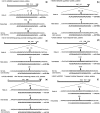Conservation and divergence of microRNAs and their functions in Euphorbiaceous plants
- PMID: 19942686
- PMCID: PMC2817462
- DOI: 10.1093/nar/gkp1035
Conservation and divergence of microRNAs and their functions in Euphorbiaceous plants
Abstract
MicroRNAs (miRNAs) are approximately 21 nt non-coding RNAs which regulate post-transcriptional gene expression. miRNAs are key regulators of nearly all essential biological processes. Aiming at understanding miRNA's functions in Euphorbiaceae, a large flowering plant family, we performed a genome-scale systematic study of miRNAs in Euphorbiaceae, by combining computational prediction and experimental analysis to overcome the difficulty of lack of genomes for most Euphorbiaceous species. Specifically, we predicted 85 conserved miRNAs in 23 families in the Castor bean (Ricinus communis), and experimentally verified and characterized 58 (68.2%) of the 85 miRNAs in at least one of four Euphorbiaceous species, the Castor bean, the Cassava (Manihot esculenta), the Rubber tree (Hevea brasiliensis) and the Jatropha (Jatropha curcas) during normal seedling development. To elucidate their function in stress response, we verified and profiled 48 (56.5%) of the 85 miRNAs under cold and drought stresses as well as during the processes of stress recovery. The results revealed some species- and condition-specific miRNA expression patterns. Finally, we predicted 258 miRNA:target partners, and identified the cleavage sites of six out of ten miRNA targets by a modified 5' RACE. This study produced the first collection of miRNAs and their targets in Euphorbiaceae. Our results revealed wide conservation of many miRNAs and diverse functions in Euphorbiaceous plants during seedling growth and in response to abiotic stresses.
Figures


Similar articles
-
Genomic insights into lineage-specific evolution of the oleosin family in Euphorbiaceae.BMC Genomics. 2022 Mar 5;23(1):178. doi: 10.1186/s12864-022-08412-z. BMC Genomics. 2022. PMID: 35246041 Free PMC article.
-
Endogenous small-noncoding RNAs and their roles in chilling response and stress acclimation in Cassava.BMC Genomics. 2014 Jul 29;15(1):634. doi: 10.1186/1471-2164-15-634. BMC Genomics. 2014. PMID: 25070534 Free PMC article.
-
Identification of novel microRNAs in Hevea brasiliensis and computational prediction of their targets.BMC Plant Biol. 2012 Feb 13;12:18. doi: 10.1186/1471-2229-12-18. BMC Plant Biol. 2012. PMID: 22330773 Free PMC article.
-
Regulation of low temperature stress in plants by microRNAs.Plant Cell Environ. 2018 Jan;41(1):1-15. doi: 10.1111/pce.12956. Epub 2017 May 16. Plant Cell Environ. 2018. PMID: 28346818 Review.
-
MicroRNAs in Woody Plants.Front Plant Sci. 2021 Aug 31;12:686831. doi: 10.3389/fpls.2021.686831. eCollection 2021. Front Plant Sci. 2021. PMID: 34531880 Free PMC article. Review.
Cited by
-
Identification of conserved and novel microRNAs from Liriodendron chinense floral tissues.PLoS One. 2012;7(9):e44696. doi: 10.1371/journal.pone.0044696. Epub 2012 Sep 18. PLoS One. 2012. PMID: 23028583 Free PMC article.
-
Identification and profiling of novel and conserved microRNAs during the flower opening process in Prunus mume via deep sequencing.Mol Genet Genomics. 2014 Apr;289(2):169-83. doi: 10.1007/s00438-013-0800-6. Epub 2013 Dec 17. Mol Genet Genomics. 2014. PMID: 24343764
-
Phylogenomic Analysis of micro-RNA Involved in Juvenile to Flowering-Stage Transition in Photophilic Rice and Its Sister Species.Cells. 2023 May 12;12(10):1370. doi: 10.3390/cells12101370. Cells. 2023. PMID: 37408207 Free PMC article.
-
Differential expression of seven conserved microRNAs in response to abiotic stress and their regulatory network in Helianthus annuus.Front Plant Sci. 2015 Sep 17;6:741. doi: 10.3389/fpls.2015.00741. eCollection 2015. Front Plant Sci. 2015. PMID: 26442054 Free PMC article.
-
Computational identification of microRNAs and their targets in cassava (Manihot esculenta Crantz.).Mol Biotechnol. 2013 Mar;53(3):257-69. doi: 10.1007/s12033-012-9521-z. Mol Biotechnol. 2013. PMID: 22388699
References
Publication types
MeSH terms
Substances
LinkOut - more resources
Full Text Sources
Research Materials

